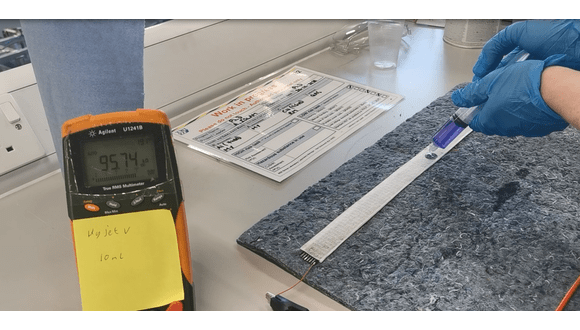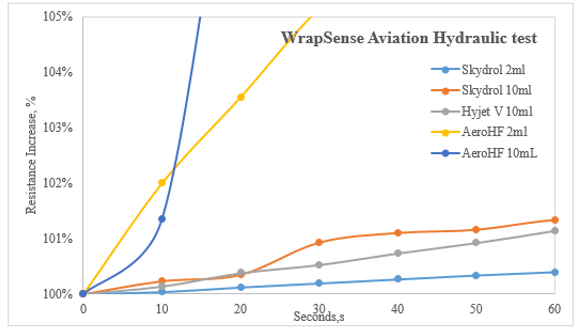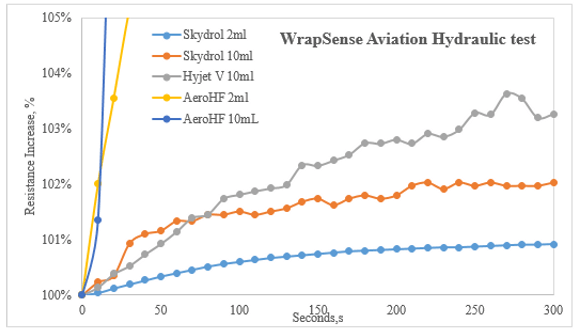Tue, 23 November, 2021
TWI partnered with Canadian SME, Direct-C, who specialise in automatic oil leak detection, to assess the performance of the new Wrapsense technology, which is based on a novel nano-composite coating material capable of detecting the slightest concentration of liquid hydrocarbons in direct contact with it.
This highly sensitive technology is ideal for detecting leakages in applications including those in oil and gas and aerospace.
Part of this work involved testing the system to see if it was capable of detecting hydrocarbons in aviation hydraulics. TWI undertook market research for commercially-available hydraulics and determined that the testing would include mineral oil-based fluids, synthetic hydrocarbon-based fluids, and phosphate ester-based fluids. The selected fluids included Eastmans’ Skydrol LD-4, the world’s bestselling common aviation hydraulic, ExxonMobil’s HyJet V, which is commercially available with a low hydrocarbon content, and ExxonMobil’s Aero HF Series, which is commercially available and has a high hydrocarbon content.
The test procedure involved the use of a syringe (for controlled application of the aviation hydraulic fluids), a multimeter, a camera to record values as well as PPE and a spill-kit in case of any spillages.
The procedure for the testing was as follows:
- Place the WrapSense sensors on top of the spill blanket
- Connect the multimeter with the sensor using clamp terminals
- Read and record the starting resistance value
- Turn on the video recording
- Prepare a 2mL and 10mL solution and impregnate the sensor
- Verify that the multimeter readings are constantly displayed and recorded for 5 minutes
- Clean the test area and pipe with wipes
 Figure 1. Example of hydraulic test. The Wrapsense sensor (white) is laid over the spill blanket and connected to the multimeter using clamps. A reading of 95.74 kOhm is displayed
Figure 1. Example of hydraulic test. The Wrapsense sensor (white) is laid over the spill blanket and connected to the multimeter using clamps. A reading of 95.74 kOhm is displayed
Two quantities (2mL and 10mL) of each hydraulic were tested, with the exception of Hyjet whose low quantity (2mL) was not sufficient to trigger the sensors. The electrical resistance for each test was obtained from the video recordings every five seconds.
Figure 2 (below) shows the results from the first sixty seconds of the five tests.
 Figure 2. WrapSense Aviation Hydraulic Test Results – One minute
Figure 2. WrapSense Aviation Hydraulic Test Results – One minute
The Skydrol 2mL test featured the lowest resistance increase with 0.39% at 60s. However, when the Skydrol quantity was increased to 10mL, the resistance increased to 1.33%. This behaviour reflects the fact that the leakage detection depends on both the hydrocarbon concentration of the fluid and the quantity of leaked product. Consequently, HyJet, when tested at 10mL, increased up to 1.13%. Finally, AeroHF, which has a high hydrocarbon concentration, showed a rapid increase in resistance within the first 10 to 20 seconds of exposure.
Similarly, Figure 3 (below) shows the WrapSense response over 5 minutes.
 Figure 3. WrapSense Aviation Hydraulic Test Results – Five minutes
Figure 3. WrapSense Aviation Hydraulic Test Results – Five minutes
This graph captured the long-term behaviour, showing that both Skydrol and HyJet made the sensor increase its electrical resistance steadily until reaching a saturation level. A confident set of alarms can be developed from the long-term behaviour by establishing thresholds of 1% increase in resistance.
The Wrapsense Project is funded under InnovateUK Project Number 105611